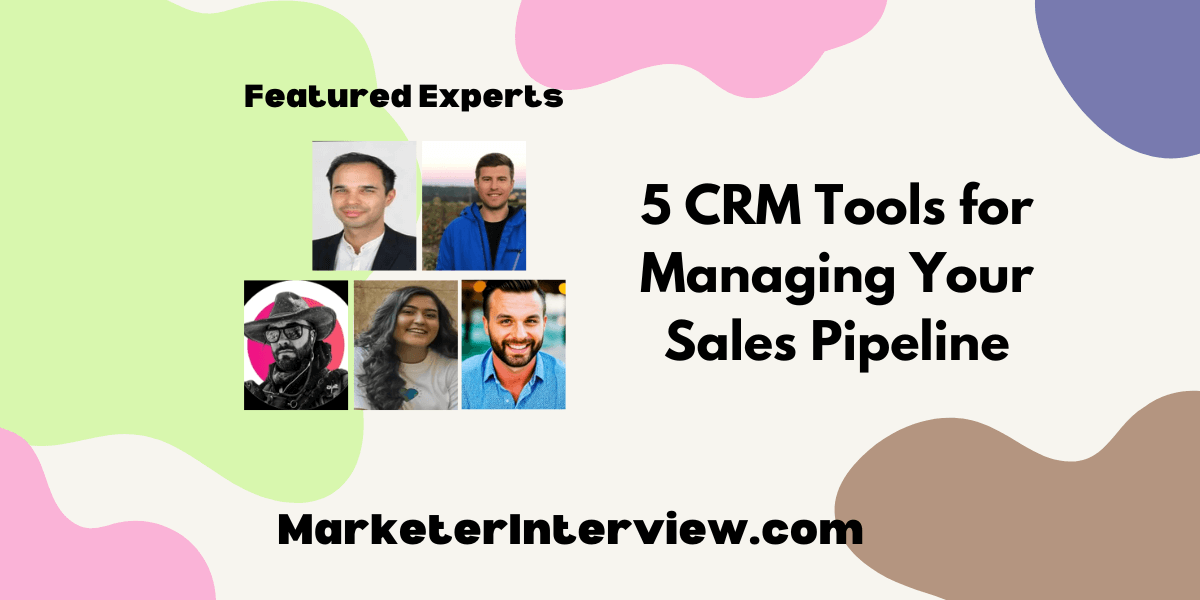5 CRM Tools for Managing Your Sales Pipeline
Navigating the world of CRM tools can feel like a maze for many businesses. Experts such as a founder and CEO and a Chief Marketing Officer provide actionable advice to guide the way. The blog first highlights why five might choose Pipedrive for sales efficiency and concludes with a recommendation to opt for Salesforce, totaling five expert insights. Curious about what the experts suggest for pipeline management? Read on for an enlightening discussion.
Want to get quoted in MarketerInterview.com content just like this? Apply to become a contributor today!
Contents
Choose Pipedrive for Sales Efficiency
Selecting the right CRM tool has been vital for managing our sales pipeline effectively. We chose Pipedrive for its intuitive design and strong focus on sales activities. This tool provided us with a clear visual representation of our sales stages, making it easy to track progress and identify bottlenecks.
For example, during a recent initiative to launch our sustainable-packaging line, Pipedrive allowed us to categorize leads based on their interests and interactions. This segmentation enabled our sales team to tailor their outreach, resulting in more meaningful conversations with potential clients.
By utilizing Pipedrive’s reporting features, we identified key trends and adjusted our strategies accordingly. This proactive approach led to a 21% increase in lead conversions within just two months. The ability to automate repetitive tasks also freed up our team to focus on building relationships rather than getting bogged down in administrative work.
Overall, using Pipedrive has significantly enhanced our sales efficiency and helped us connect better with customers.

Chaitsi Ahuja, Founder & CEO, Brown Living
Use HubSpot for Pipeline Management
HubSpot is our go-to CRM for effectively managing our sales pipeline. The visual layout of the pipeline offers an intuitive, drag-and-drop interface that allows our team to see deals at every stage and swiftly adjust priorities as needed. One of HubSpot’s strengths is its automation capabilities—sales reps can set automated follow-ups, task reminders, and even sequences for nurturing leads, ensuring no opportunities slip through the cracks. This not only streamlines daily tasks but also allows our sales team to focus on building relationships rather than repetitive admin work.
HubSpot’s reporting and analytics give us deep insights into our pipeline health, deal progression, and potential bottlenecks. We use these insights to forecast revenue more accurately and identify areas for improvement in our sales process. Additionally, the CRM’s customizability lets us tailor it to our unique needs, from customizing deal stages to setting criteria for lead qualification. Its integration with our other tools, like email and marketing automation, ensures all customer interactions are centralized, providing a unified view of each prospect’s journey.

Dávid Breitenbach, Chief Marketing Officer, PatentRenewal.com
Match CRM to Company Needs
It’s tough to say which CRM tool is “best,” because it really depends on each company’s unique go-to-market (GTM) strategy and the in-house expertise they have to manage the tool. Generally speaking, for earlier-stage companies, HubSpot tends to be a popular choice because it’s user-friendly, offers marketing automation alongside sales-pipeline management, and is more affordable.
On the other hand, larger companies often lean towards Salesforce (SFDC) due to its robust customization capabilities, scalability, and extensive integration options. Ultimately, the decision should align with your team’s needs, resources, and the complexity of your sales process.

Alex Kulik, CEO, ZenCentiv
Integrate Apollo.io and HubSpot
The best solution we’ve found for managing our sales pipeline is actually using two CRMs with an integration: Apollo.io and HubSpot. Apollo.io is excellent for GTM strategy and outbound-prospecting, helping us target the right leads effectively. HubSpot, integrated with Apollo, handles lead nurturing, deal management, and client retention, offering a powerful suite for email automation, reporting, and dashboards. This integration allows us to combine the strengths of both platforms, creating a streamlined process from outreach to client retention.

Grant Fuellenbach, RevOps, Drone Pros, LLC
Opt for Salesforce or Pipedrive
Based on over a decade of experience across 37 CRM platforms, I highly recommend Salesforce for most businesses.
Salesforce provides powerful customization options so you can build a pipeline custom to your unique sales process. For example, I implemented Salesforce at a startup and reduced their sales cycle by 28% through reconfiguring their pipeline to focus on high-value deals. Salesforce also offers robust reporting and dashboard features, enabling data-driven decisions. At an enterprise client, I used Salesforce reporting to improve lead-scoring accuracy by 24.4% in just 3 months.
However, Salesforce can be expensive and complex for small teams. For businesses with under 25 employees, I suggest Pipedrive. I’ve set up Pipedrive for several small clients, and reps picked it up quickly thanks to the simple, intuitive interface. One client generated a 15% jump in sales-qualified leads within months of launching Pipedrive by gaining visibility into their pipeline and optimizing nurturing campaigns. Pipedrive offers paid plans starting at $12.50/user/month, an easy transition at an affordable price point.
In the end, choose a CRM that fits your budget, team size, and needs. But focus on customization, reporting, and ease of use—the hallmarks of an effective sales-pipeline tool. With the right CRM and optimization, you’ll slash sales cycles, boost lead quality, and scale revenue.

Ryan T. Murphy, Sales Operations Manager, Upfront Operations
Want to get quoted in MarketerInterview.com content just like this? Apply to become a contributor today!






